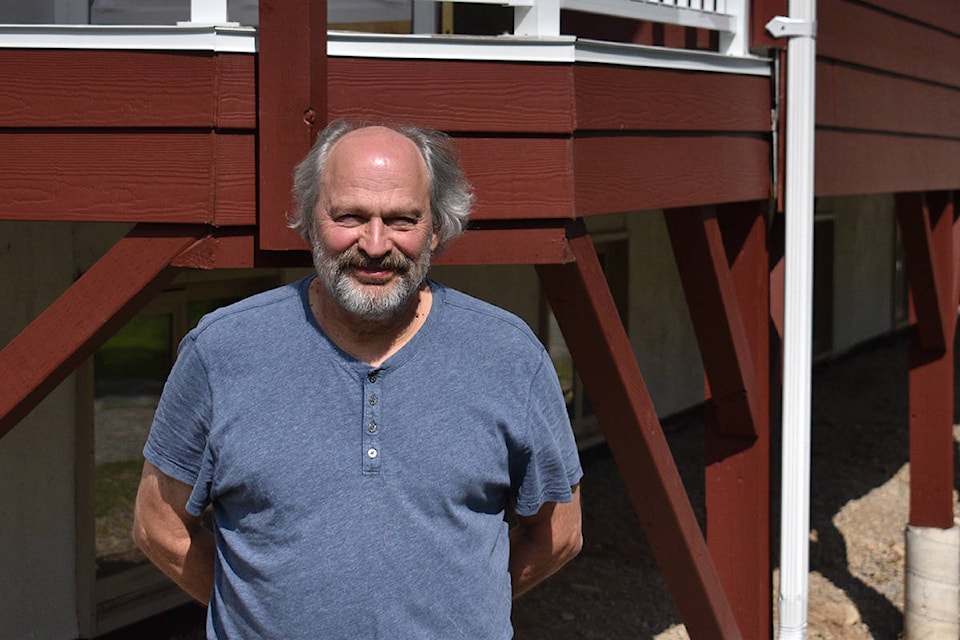During B.C.’s heatwave, the air felt cold when stepping into Martin Holzbauer’s hand-built Thornhill house. With the sun beating down and temperatures touching 40 C, his home felt around 20 degrees cooler.
And he doesn’t have an air conditioner.
Instead, Holzbauer’s low emissions home relies on special building features to keep him cool and minimize his environmental impact — something that is very important to him even if it was more expensive to build initially.
“My brother actually has a bumper sticker on his truck, ‘he who has the most toys when he dies wins,’ which explains exactly how some people really look at it,” Holzbauer said.
“But to me, it’s not quite the correct attitude in my opinion.”
Growing up in Germany, Holzbauer was exposed to different types of homes and construction techniques than typically seen in Canada. He completed his apprenticeship at his father’s general construction company and obtained his journeyman ticket before coming to Canada.
“In Europe, they say the way it goes is you build a house, and your kids pay off the mortgage, because mortgages in a lot of places are 50-year mortgages, because of the higher costs,” Holzbauer said. “But the buildings last a lot longer as compared to wood construction,” Holzbauer said.
Despite higher initial costs, Holzbauer said the savings on heating and utilities offset the extra money required up front to construct an energy efficient home.
He said even a little common sense can go a long way, and shared a story about a family building a brand new house a few years ago. At the time, new building code requirements were set to come into effect in a matter of months.
The client chose not to install energy efficient windows, which would have cost between $2,000 and $5,000, instead opting for regular windows while they were still permitted.
“They said, ‘no, it’s not part of the code, we’re not going to do it,’ but they spent $15,000 on granite countertops,” Holzbauer said.
“I don’t like paying utility bills, and I also like to be comfortable, and so yes, it costs more money but in the long run you actually save a lot more.”
Holzbauer said he pays around $1,000 in utility costs per year for the property, which also contains two shops, the larger of two having some of the same energy efficient aspects as his house.
Some of the design features incorporated into the home include 13-inch thick walls, triple-glazed R8 rated windows, a south facing sun room to add heat to the rest of the home when open and concrete and foam making up the main components of floors and walls.
“Energy efficient works both ways. It keeps you cool with summer, and keeps it warm in the winter with minimal effort,” Holzbauer said.
“If I was a little bit cold, I would just cook a meal and it was comfortable again.”
Holzbauer said that his home’s heat retention is so efficient that on a cold February day, cooking a casserole in the oven for an hour-and-a-half can raise the interior temperature into the mid-20s, even if it is minus 20 C outside.
In Canada, energy consumption tends to be higher in the winter, because people need to heat their homes and rely more on artificial lighting. But with extreme weather events increasing in frequency and severity like the recent B.C. heatwave, the need for air conditioning can increase consumption in the summer.
For Holzbauer, energy efficient homes are a way to break the vicious cycle, where climate change induced conditions force people to use more energy like air conditioning to cope, which in turn contributes to climate change.
Energy efficiency can also increase the safety of a home, according to Holzbauer. He shared a story about someone in Terrace who went on vacation during the winter and returned to thousands of dollars in damage because the pipes froze. That is in contrast to a net-zero home in Calgary, which suffered a heating system failure during the winter.
“It was still above freezing when they came back after two weeks, so it it’s a safety thing, and with this place, metal roof and stucco, if there would be a fire, I wouldn’t have to really worry,” he said.
“The same thing, even in a fire, if you have energy efficient windows that will actually help as well.”
Holzbauer has attempted to install solar panels and a wind turbine on the property to take the next step towards his net-zero goal, but has run into opposition from the Regional District of Kitimat-Stikine over zoning bylaws.
But despite his frustration over the situation, Holzbauer still strongly advocates for others to pursue net-zero and energy efficient construction for both the environmental and practical benefits.
